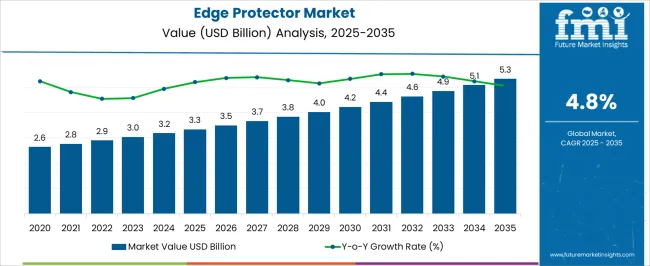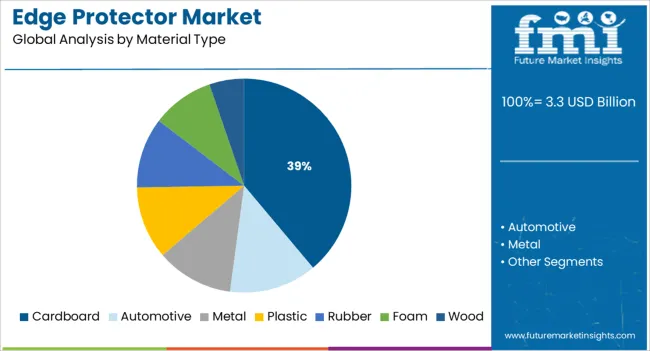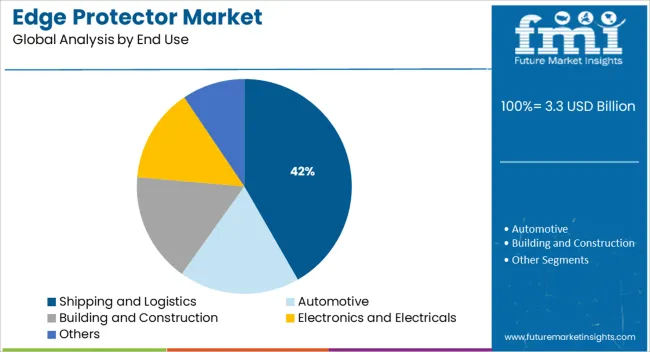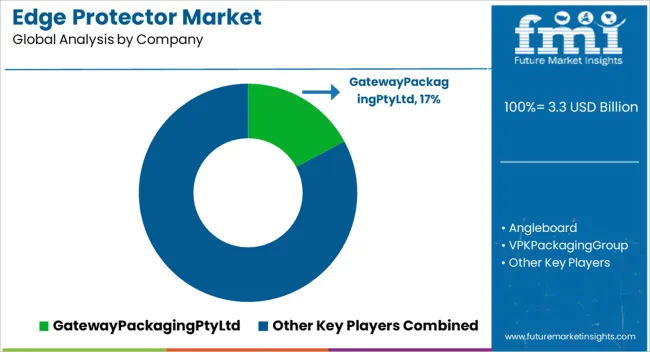The Edge Protector Market is estimated to be valued at USD 3.3 billion in 2025 and is projected to reach USD 5.3 billion by 2035, registering a compound annual growth rate (CAGR) of 4.8% over the forecast period.

| Metric | Value |
|---|---|
| Edge Protector Market Estimated Value in (2025 E) | USD 3.3 billion |
| Edge Protector Market Forecast Value in (2035 F) | USD 5.3 billion |
| Forecast CAGR (2025 to 2035) | 4.8% |
The edge protector market is experiencing notable growth as supply chains increasingly prioritize the safeguarding of goods during transit, storage, and stacking. Driven by the rapid expansion of global trade networks and the growing dependency on third-party logistics, the need for protective packaging solutions has risen substantially. Edge protectors have become essential in preventing product damage, reducing return rates, and enhancing load stability, especially in sectors such as manufacturing, consumer electronics, food and beverage, and e-commerce.
The trend toward sustainable packaging materials is also contributing to the market’s evolution, with a noticeable shift toward recyclable and biodegradable protectors. Regulatory push for reduced plastic usage and growing environmental awareness have encouraged widespread adoption of cardboard-based edge solutions.
Additionally, operational efficiencies enabled by automation in packaging lines have increased the demand for standardized and lightweight edge protectors With industrial expansion in emerging economies and heightened focus on supply chain optimization, the market is positioned for sustained growth over the coming years.
The market is segmented by Product Type, Material Type, and End Use and region. By Product Type, the market is divided into Angulars, Flats, and Custom made. In terms of Material Type, the market is classified into Cardboard, Automotive, Metal, Plastic, Rubber, Foam, and Wood. Based on End Use, the market is segmented into Shipping and Logistics, Automotive, Building and Construction, Electronics and Electricals, and Others. Regionally, the market is classified into North America, Latin America, Western Europe, Eastern Europe, Balkan & Baltic Countries, Russia & Belarus, Central Asia, East Asia, South Asia & Pacific, and the Middle East & Africa.

The angulars segment is expected to hold 46.5% of the edge protector market’s revenue share in 2025, establishing itself as the most dominant product type. This leadership is supported by the superior structural strength and corner protection offered by angular edge protectors during palletized transportation. These protectors are widely adopted due to their ability to prevent crushing, shifting, and abrasion of goods in transit.
Their compatibility with stretch film and strapping operations has made them suitable for high-speed packaging environments across industries. The adaptability of angulars to varying load dimensions, along with their uniform pressure distribution, has further strengthened their appeal. Manufacturers have increasingly integrated angular designs with reinforced materials to improve resilience under compression.
As packaging automation becomes standard across warehouses and logistics hubs, the preference for precisely engineered angular protectors has grown Their widespread usage in pallet wrapping and bundling operations, combined with minimal material wastage and easy recyclability, has reinforced their dominant market position.

Cardboard is projected to account for 38.9% of the edge protector market revenue share in 2025, highlighting its role as the leading material type. The growth of this segment is driven by heightened demand for environmentally sustainable and cost-efficient protective packaging solutions. Cardboard edge protectors offer a favorable balance between rigidity and recyclability, making them suitable for a wide range of applications from light consumer goods to industrial shipments.
The segment has benefitted from evolving corporate sustainability goals and increasing restrictions on plastic-based packaging materials. Manufacturers have continued to invest in multi-ply and laminated cardboard technologies to enhance impact resistance and water repellence, enabling better performance under diverse environmental conditions.
Cardboard also allows for easy customization and printing, which supports branding and traceability needs in B2B and B2C logistics As circular economy principles gain ground globally, cardboard-based protectors are being prioritized for their low carbon footprint and ease of integration into existing recycling systems.

The shipping and logistics segment is anticipated to contribute 41.7% of the overall edge protector market revenue share in 2025, establishing it as the leading end-use sector. This dominance is being propelled by the exponential growth of global and last-mile delivery operations. The increasing complexity and volume of goods movement, particularly from warehousing to distribution centers and retail endpoints, has intensified the need for damage mitigation and secure packaging.
Edge protectors are being used extensively to stabilize loads, minimize transit damage, and optimize stacking efficiency within cargo containers and freight vehicles. Their compatibility with varied packaging materials and ability to reinforce structural integrity during long-haul transportation has increased their utility.
Rising fuel costs and regulatory constraints on waste have compelled logistics companies to reduce returns and re-shipments, further amplifying the demand for effective protective packaging As supply chain resilience becomes a strategic priority, edge protectors are emerging as essential components of performance-driven logistics operations.
Design of the overall packaging system determines the functionality and effectiveness of the packaging solution. Edge protectors used prominently in shipping and transportation play a crucial role in product protection and product safety.
They also minimize the probability of product damage and ensure the arrangement of bulk items throughout the transportation process. The global edge protector market is characterized by packaging solutions particularly designed for transportation and shipping of bulk products.
Shipping of material or exporting of items requires packaging materials, in order to prevent products from getting harmed. Primary packaging formats such as rigid boxes, corrugated boxes and folding cartons are widely used for primary and secondary packaging of consumer goods.
Complex and prolonged supply chains result in damage to such rigid primary and secondary packaging formats. Edge protectors play a critical part in protecting primary packaging from getting damaged during supply chain and logistics operations. Edge protectors reduces the chance of loss that can be caused during replacement of the product.
Edge protector provides an effective cushioning functionality for carrying and transporting heavy weight batches of consumer products. Edge protectors also provide internal support to packaging material, which also eases the transportation of products. One of the value added feature of edge protector is that it maintains the static strength of the material that does not allow the material to get compressed when packed in a box.
The global market for edge protectors is characterized by manufacturers supplying edge protectors in various product designs including angular edge protectors, flat edge protectors and custom made edge protectors.
The global market for edge protector is influenced by transport and shipping requirement in industrial markets. Edge protectors offering functional resistance to wear and tear are widely used for the construction industry. Edge protector prevents valuable material from falling apart and also from breakage.
Cardboard edge protectors are increasingly replacing wood edge protectors as cardboard offers better durability. Edge protectors are widely used over other products as these are recyclable and biodegradable. Edge protectors with advanced design material properties can sustain impact from moisture, mechanical stress, heat, and light.

Some of the players of edge protector markets are Gateway Packaging Pty Ltd, Samuel Grant Group Ltd, VPK Packaging Group, Propagroup, Angleboard, Kunert Gruppe, Alsamex Products Ltd, Nomaco, and Great Northern Laminations.

The report is a compilation of first-hand information, qualitative and quantitative assessment by industry analysts, inputs from industry experts and industry participants across the value chain.
The report provides in-depth analysis of parent market trends, macro-economic indicators and governing factors along with market attractiveness as per segments. The report also maps the qualitative impact of various market factors on market segments and geographies.
The global edge protector market is estimated to be valued at USD 3.3 billion in 2025.
The market size for the edge protector market is projected to reach USD 5.3 billion by 2035.
The edge protector market is expected to grow at a 4.8% CAGR between 2025 and 2035.
The key product types in edge protector market are angulars, flats and custom made.
In terms of material type, cardboard segment to command 38.9% share in the edge protector market in 2025.






Our Research Products

The "Full Research Suite" delivers actionable market intel, deep dives on markets or technologies, so clients act faster, cut risk, and unlock growth.

The Leaderboard benchmarks and ranks top vendors, classifying them as Established Leaders, Leading Challengers, or Disruptors & Challengers.

Locates where complements amplify value and substitutes erode it, forecasting net impact by horizon

We deliver granular, decision-grade intel: market sizing, 5-year forecasts, pricing, adoption, usage, revenue, and operational KPIs—plus competitor tracking, regulation, and value chains—across 60 countries broadly.

Spot the shifts before they hit your P&L. We track inflection points, adoption curves, pricing moves, and ecosystem plays to show where demand is heading, why it is changing, and what to do next across high-growth markets and disruptive tech

Real-time reads of user behavior. We track shifting priorities, perceptions of today’s and next-gen services, and provider experience, then pace how fast tech moves from trial to adoption, blending buyer, consumer, and channel inputs with social signals (#WhySwitch, #UX).

Partner with our analyst team to build a custom report designed around your business priorities. From analysing market trends to assessing competitors or crafting bespoke datasets, we tailor insights to your needs.
Supplier Intelligence
Discovery & Profiling
Capacity & Footprint
Performance & Risk
Compliance & Governance
Commercial Readiness
Who Supplies Whom
Scorecards & Shortlists
Playbooks & Docs
Category Intelligence
Definition & Scope
Demand & Use Cases
Cost Drivers
Market Structure
Supply Chain Map
Trade & Policy
Operating Norms
Deliverables
Buyer Intelligence
Account Basics
Spend & Scope
Procurement Model
Vendor Requirements
Terms & Policies
Entry Strategy
Pain Points & Triggers
Outputs
Pricing Analysis
Benchmarks
Trends
Should-Cost
Indexation
Landed Cost
Commercial Terms
Deliverables
Brand Analysis
Positioning & Value Prop
Share & Presence
Customer Evidence
Go-to-Market
Digital & Reputation
Compliance & Trust
KPIs & Gaps
Outputs
Full Research Suite comprises of:
Market outlook & trends analysis
Interviews & case studies
Strategic recommendations
Vendor profiles & capabilities analysis
5-year forecasts
8 regions and 60+ country-level data splits
Market segment data splits
12 months of continuous data updates
DELIVERED AS:
PDF EXCEL ONLINE
Leading Providers & Market Share in Edge Protector Manufacturing
Foam Edge Protectors Market Size and Share Forecast Outlook 2025 to 2035
Assessing Foam Edge Protectors Market Share & Industry Insights
Paper Edge Protector Market Size and Share Forecast Outlook 2025 to 2035
Key Players & Market Share in the Paper Edge Protectors Industry
Molded Fiber Pulp Edge Protectors Market Size and Share Forecast Outlook 2025 to 2035
Edge Bead Remover (EBR) Market Size and Share Forecast Outlook 2025 to 2035
Edge Security Market Size and Share Forecast Outlook 2025 to 2035
Edge Banders Market Size and Share Forecast Outlook 2025 to 2035
Edge AI for Smart Manufacturing Market Size and Share Forecast Outlook 2025 to 2035
Edge Bending Machine Market - Trends & Forecast 2025 to 2035
Edge Server Market Trends – Growth & Forecast 2025 to 2035
Edge AI Market Trends – Growth, Demand & Forecast through 2034
Edge Data Centers Market
Hedge Shears Market Size and Share Forecast Outlook 2025 to 2035
Wedge Wire Screen Market Size and Share Forecast Outlook 2025 to 2035
Wedge Boots Market Growth - Trends & Demand Forecast to 2025 to 2035
Hedge Trimmers Market Growth - Trends & Forecast 2025 to 2035
Wedge Pressure Catheters Market
5G Edge Cloud Network and Services Market Size and Share Forecast Outlook 2025 to 2035

Thank you!
You will receive an email from our Business Development Manager. Please be sure to check your SPAM/JUNK folder too.
Chat With
MaRIA